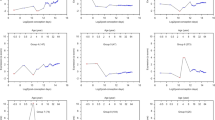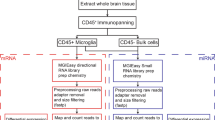Abstract
We present a spatio-temporal assessment of microRNA (miRNA) expression throughout early human brain development. We assessed the prefrontal cortex, hippocampus and cerebellum of 18 normal human donor brains spanning infancy through adolescence by RNA-seq. We discovered differentially expressed miRNAs and broad miRNA patterns across both temporal and spatial dimensions, and between male and female prefrontal cortex. Putative target genes of the differentially expressed miRNAs were identified, which demonstrated functional enrichment for transcription regulation, synaptogenesis and other basic intracellular processes. Sex-biased miRNAs also targeted genes related to Wnt and transforming growth factor-beta pathways. The differentially expressed miRNA targets were highly enriched for gene sets related to autism, schizophrenia, bipolar disorder and depression, but not neurodegenerative diseases, epilepsy or other adult-onset psychiatric diseases. Our results suggest critical roles for the identified miRNAs in transcriptional networks of the developing human brain and neurodevelopmental disorders.
This is a preview of subscription content, access via your institution
Access options
Subscribe to this journal
Receive 12 print issues and online access
$259.00 per year
only $21.58 per issue
Buy this article
- Purchase on Springer Link
- Instant access to full article PDF
Prices may be subject to local taxes which are calculated during checkout




Similar content being viewed by others
References
Oldham MC, Konopka G, Iwamoto K, Langfelder P, Kato T, Horvath S et al. Functional organization of the transcriptome in human brain. Nat Neurosci 2008; 11: 1271–1282.
Kang HJ, Kawasawa YI, Cheng F, Zhu Y, Xu X, Li M et al. Spatio-temporal transcriptome of the human brain. Nature 2011; 478: 483–489.
Shao NY, Hu HY, Yan Z, Xu Y, Hu H, Menzel C et al. Comprehensive survey of human brain microRNA by deep sequencing. BMC Genomics 2010; 11: 409.
Hu HY, Guo S, Xi J, Yan Z, Fu N, Zhang X et al. MicroRNA expression and regulation in human, chimpanzee, and macaque brains. PLoS Genet 2011; 7: e1002327.
Somel M, Guo S, Fu N, Yan Z, Hu HY, Xu Y et al. MicroRNA, mRNA, and protein expression link development and aging in human and macaque brain. Genome Res 2010; 20: 1207–1218.
Somel M, Liu X, Tang L, Yan Z, Hu H, Guo S et al. MicroRNA-driven developmental remodeling in the brain distinguishes humans from other primates. PLoS Biol 2011; 9: e1001214.
Qureshi IA, Mehler MF . Emerging roles of non-coding RNAs in brain evolution, development, plasticity and disease. Nat Rev Neurosci 2012; 13: 528–541.
Anders S, Huber W . Differential expression analysis for sequence count data. Genome Biol 2010; 11: R106.
Robinson MD, McCarthy DJ, Smyth GK . edgeR: a Bioconductor package for differential expression analysis of digital gene expression data. Bioinformatics 2010; 26: 139–140.
Robles JA, Qureshi SE, Stephen SJ, Wilson SR, Burden CJ, Taylor JM . Efficient experimental design and analysis strategies for the detection of differential expression using RNA-Sequencing. BMC Genomics 2012; 13: 484.
Lewis BP, Burge CB, Bartel DP . Conserved seed pairing, often flanked by adenosines, indicates that thousands of human genes are microRNA targets. Cell 2005; 120: 15–20.
Wang X . miRDB: a microRNA target prediction and functional annotation database with a wiki interface. RNA 2008; 14: 1012–1017.
Huang da W, Sherman BT, Lempicki RA . Systematic and integrative analysis of large gene lists using DAVID bioinformatics resources. Nat Protoc 2009; 4: 44–57.
Wall DP, Pivovarov R, Tong M, Jung JY, Fusaro VA, DeLuca TF et al. Genotator: a disease-agnostic tool for genetic annotation of disease. BMC Med Genomics 2010; 3: 50.
Dunham I, Kundaje A, Aldred SF, Collins PJ, Davis CA, Doyle F et al. An integrated encyclopedia of DNA elements in the human genome. Nature 2012; 489: 57–74.
Jazin E, Cahill L . Sex differences in molecular neuroscience: from fruit flies to humans. Nat Rev Neurosci 2010; 11: 9–17.
Abel KM, Drake R, Goldstein JM . Sex differences in schizophrenia. Int Rev Psychiatry 2010; 22: 417–428.
Werling DM, Geschwind DH . Sex differences in autism spectrum disorders. Curr Opin Neurol 2013; 26: 146–153.
Chen K, Rajewsky N . The evolution of gene regulation by transcription factors and microRNAs. Nat Rev Genet 2007; 8: 93–103.
Hobert O . Gene regulation by transcription factors and microRNAs. Science 2008; 319: 1785–1786.
Freese JL, Pino D, Pleasure SJ . Wnt signaling in development and disease. Neurobiol Dis 2010; 38: 148–153.
Krieglstein K, Zheng F, Unsicker K, Alzheimer C . More than being protective: functional roles for TGF-beta/activin signaling pathways at central synapses. Trends Neurosci 2011; 34: 421–429.
Button KS, Ioannidis JP, Mokrysz C, Nosek BA, Flint J, Robinson ES et al. Power failure: why small sample size undermines the reliability of neuroscience. Nat Rev Neurosci 2013; 14: 365–376.
Acknowledgements
We thank the Allen Institute for Brain Science. This work was supported by the Intramural Research Program (IRP) of the National Institute of Child Health and Human Development, NIH. MNZ was also supported by the Baylor College of Medicine Medical Scientist Training Program (MSTP) and the NIH-Oxford/Cambridge Biomedical Scholars Program. The funders had no role in study design, data collection and analysis, decision to publish, or preparation of the manuscript.
Author information
Authors and Affiliations
Corresponding authors
Ethics declarations
Competing interests
The authors declare no conflict of interest.
Additional information
Supplementary Information accompanies the paper on the Molecular Psychiatry website
Supplementary information
Rights and permissions
About this article
Cite this article
Ziats, M., Rennert, O. Identification of differentially expressed microRNAs across the developing human brain. Mol Psychiatry 19, 848–852 (2014). https://doi.org/10.1038/mp.2013.93
Received:
Revised:
Accepted:
Published:
Issue Date:
DOI: https://doi.org/10.1038/mp.2013.93
Keywords
This article is cited by
-
Non-coding RNAs in disease: from mechanisms to therapeutics
Nature Reviews Genetics (2024)
-
Sex-biased gene and microRNA expression in the developing mouse brain is associated with neurodevelopmental functions and neurological phenotypes
Biology of Sex Differences (2023)
-
A Literature Review of Traumatic Brain Injury Biomarkers
Molecular Neurobiology (2022)
-
The Transcription Factor, α1ACT, Acts Through a MicroRNA Network to Regulate Neurogenesis and Cell Death During Neonatal Cerebellar Development
The Cerebellum (2022)
-
MiREDiBase, a manually curated database of validated and putative editing events in microRNAs
Scientific Data (2021)



